Among reptiles, chameleons are particularly charming to keep as pets.
With so many peculiar and totally unique characteristics, chameleons are more prevalent in pop culture than most of their cold-blooded contemporaries.
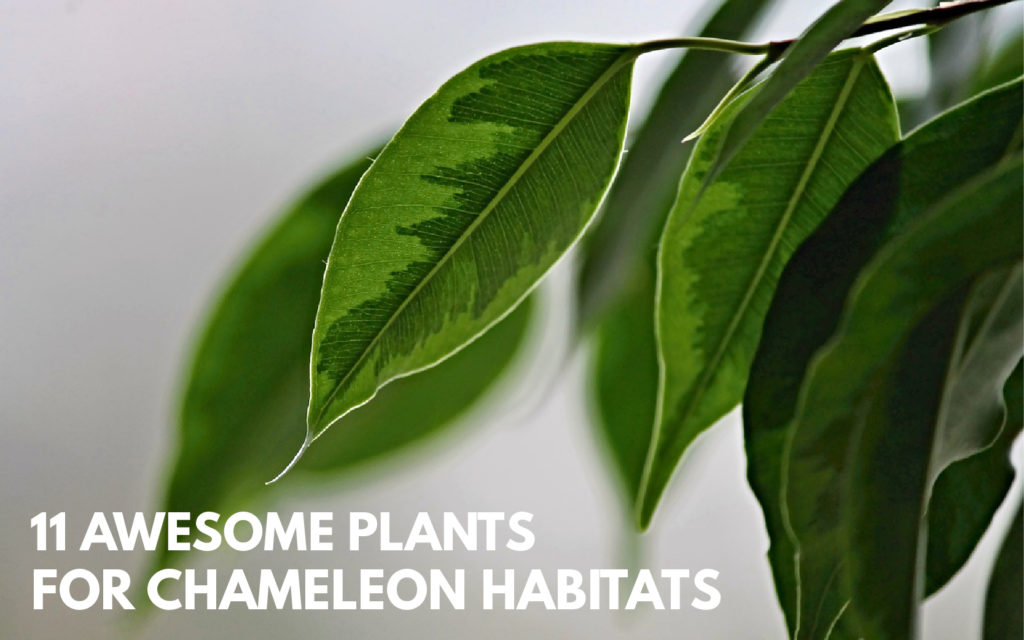
Quick Navigation
A Few Things About Keeping Pet Chameleons
Chameleons are remarkable creatures, displaying some unusual quirks that humans tend to find universally charming.
For starters: those eyes. Chameleons can move each eye independently of the other. Even cooler, they can rotate their eyes almost 360 degrees – something no other animal on earth can do.
Another uncommon feature chameleons have? Their hands have opposable digits, giving them the ability to grip things in a very human-like way that you won’t see any other lizard doing.
There’s also the crazy-long and powerful tongue that the chameleon uses to clean its own eyes and catch far-away prey – and an incredibly endearing personality.
Chameleons are definitely worth looking into once you have a bit of experience with other pet lizard species.
If you decide to bring one home to call your own, do the right thing and create a habitat your pet will love. Part of this responsibility is populating the tank with vibrant plants to help keep your chameleon happy and healthy.
Why Plants Are Important in a Chameleon Habitat?
A key component of building quality chameleon digs is adding some plants. Live plants serve lots of useful purposes inside the habitat.
Here are just of a few of the benefits of live plants:
- Plants help maintain healthy humidity levels in the tank.
- Plants provide a place for chameleons to hide, which helps them to feel safe and secure in their environment.
- Terrarium plants help clean the air, helping foster a healthier habitat for your pet.
- Chameleons love to climb, and providing the right plants allows them ample opportunity to do so.
In the wild, most chameleons spend much of their lives climbing in and hiding behind plants and trees. Your chameleon will be happiest if you recreate something natural in their tank.
- CLEANER AIR: Our variety pack of live air purifying plants helps keep your indoor air fresh and...
- PERFECT FOR ANY SPACE: Whether you're looking to spruce up your home office or add a touch of...
- ELEVATE MOOD & WELLBEING: Plants make us happy. They give us life, fresh air and a sense of calm -...
11 Suitable Plants for Chameleons
The following plants are safe and suitable for use in a chameleon habitat.
Choose plants that you can properly care for, and those that will best fit your lifestyle and your lizard’s preferences.
Shoot for a variety of strong, woody plants, trailing vines, and other interesting flora to give your chameleon a habitat that most closely mimics its natural habitat.
1. Weeping Fig
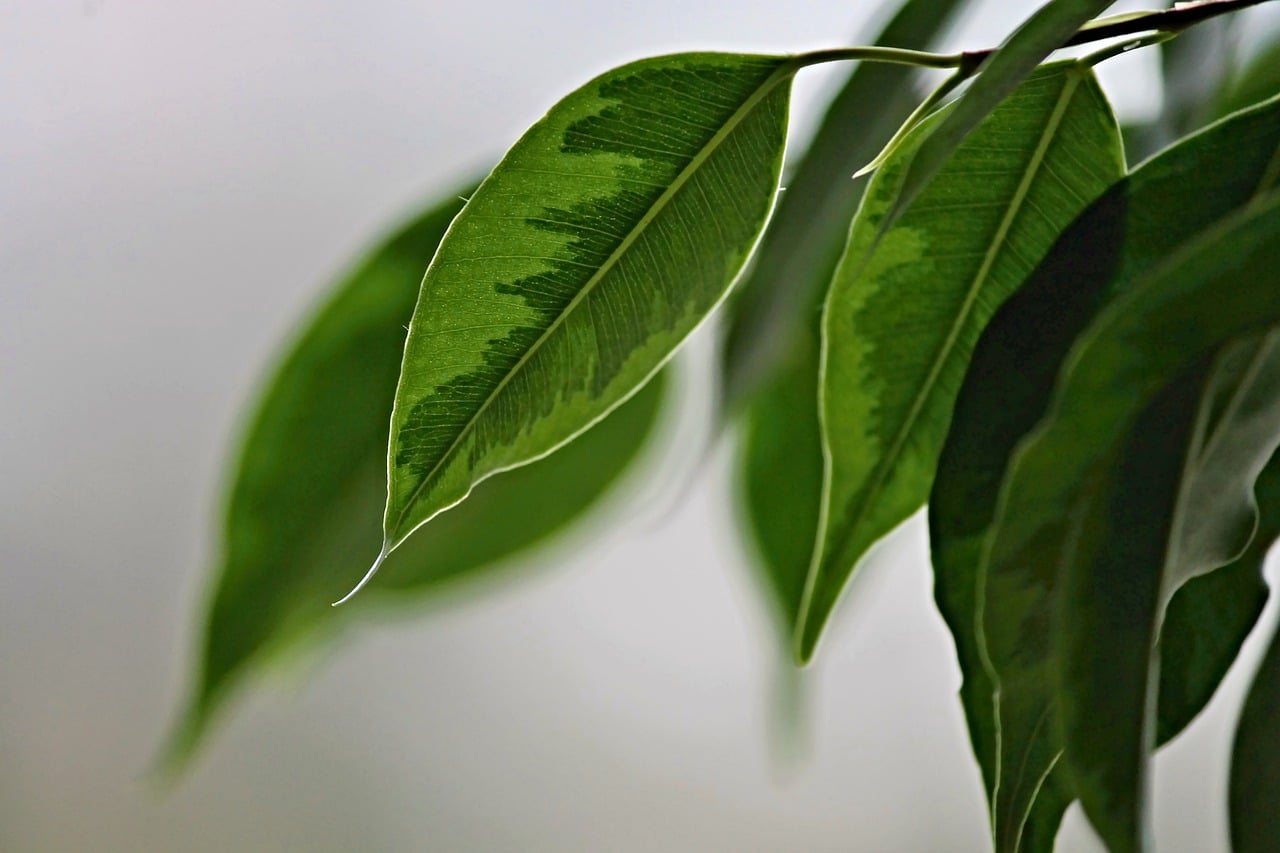
There are literally hundreds of Ficus species out there. One of the most likely to be used for a chameleon habitat is Ficus benjamina.
For those of us who aren’t actual botanists, it’s commonly called the Weeping Fig (or the Benjamin Fig, depending on where you buy it).
These Ficus are beautiful and hardy, although they do have their quirks.
- Lighting: Most Ficus varieties do much better when they get at least some actual sunlight. If you can’t place your vivarium near a window, take your Ficus out and place it in a sunny window once in a while.
- Water and Soil: Another thing about ficus is that they can be a bit touchy about water. They can’t be allowed to get too dry, but it’s also important not to overwater them. A good rule of thumb is to allow the top ½ – 1 inch of soil to dry out before watering. When you water, aim to get the soil damp rather than wet. If you’re not watering enough, a Ficus will look dried out and begin to lose leaves.
- General Care Tips: Weeping figs don’t really like being moved around. In fact, they may just drop all their leaves in defiance. Once you’ve established a happy little Ficus benjamina, it’s best not to relocate it. Oh, and they don’t take kindly to getting too hot; avoid placing your Weeping Fig too close to any heat lamps or hot bulbs.
Overall, Ficus are strong and fairly easy to grow. They’ll put up with a bit of bumbling on the grower’s part before showing signs of strain.
Know that when a Ficus plant breaks or is cut, the resulting sap can be an irritant to your lizard. If this happens, remove the injured plant until the cut has sealed up again.
2. Rubber Tree
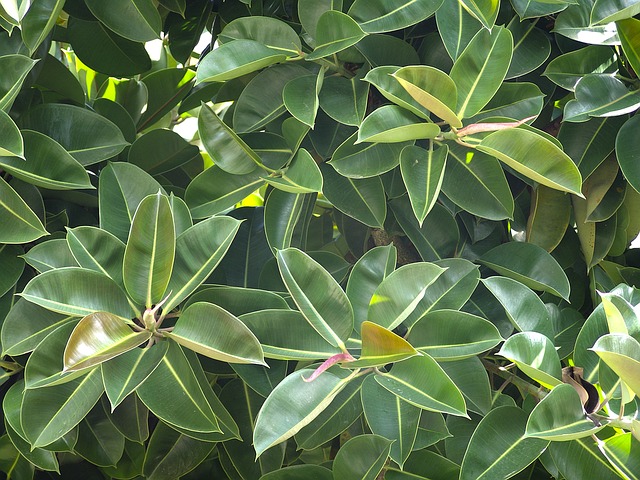
Also in the Ficus family (Ficus elastica, to be exact), the Rubber Tree (or Rubber Plant) is a cool pick for your Chameleon tank.
Rich green foliage and sturdy stalks are only a part of their overall appeal.
Of course, the Rubber Tree is – well, a tree.
Therefore, you need to be mindful that this Ficus can grow to be several feet high. Obviously, that’s not ideal for the majority of home lizard tanks.
Also, you should be aware that the sap of the rubber tree can be midly toxic. If you notice that your Chameleons is eating a lot of leaves or excess sappiness, it may be best to remove it from the setup.
Stay on top of pruning your Rubber Tree to keep it under control.
- Lighting: Rubber Trees enjoy partial to full exposure, but will wither in too-hot or too-bright conditions.
- Water and Soil: Rubber Plants love humidity. However, they don’t love being overwatered. Keep them moist, but not drenched – and watch for signs of too much water (like yellow leaves). A good houseplant soil blend is usually a good pick for Rubber Plants. Ensure good drainage, and replant when roots begin to overgrow the pot. Choose pots that aren’t more than a couple inches larger than the root ball; Rubber Trees like to have somewhat snug accommodations.
- General Care Tips: This is one of the hardier Ficus varieties you can choose for your chameleon habitat. It’s pretty adaptable and low maintenance as far as Ficus go. One of the first signs of trouble in a Rubber Tree is leaf dropping. If this happens, it’s likely the plant needs to be provided with more light during the day.
3. Golden Pothos
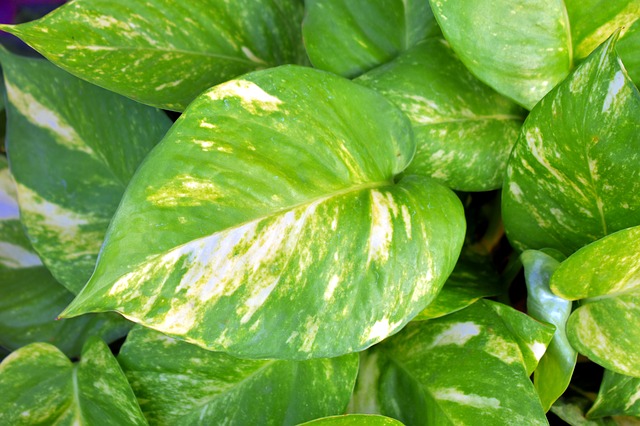
The common name for Golden pothos is Devil’s Ivy, which comes from the fact that this plant is almost impossible to kill.
A few other names it may go by include Hunter’s Robe, Solomon Islands Ivy, and Taro Vine.
With brilliant yellow-green foliage, Golden pothos produces fast-growing vines that trail gracefully across anything in its path.
- Lighting: The indomitable pothos will thrive in almost any type of lighting. As long as it’s nothing extreme, these plants will happily grow in low light or near-full exposure. An interesting note about lighting and Golden pothos plants: the amount and filtration level of light will affect the amount of golden streaking in the leaves.
- Water and Soil: Pothos don’t put down deep roots, so they don’t need deep watering. Allow the soil to dry out just a bit between waterings. If you go too long, your pothos leaves may begin to droop and look rather pathetic. Often, like magic, they’ll spring back to life not long after you give them a bit of water. Not that it’s advisable to let your plants get so parched, but pothos has a knack for surviving such droughts. Soil-wise, pothos plants do well with a basic houseplant mix. They also need adequate drainage to avoid root issues.
- General Care Tips: Since these plants are so adaptable, they usually tolerate a variety of conditions. The vines can be trimmed back to encourage more density, and you can take endless cuttings to start new Golden pothos plants.
4. Yucca
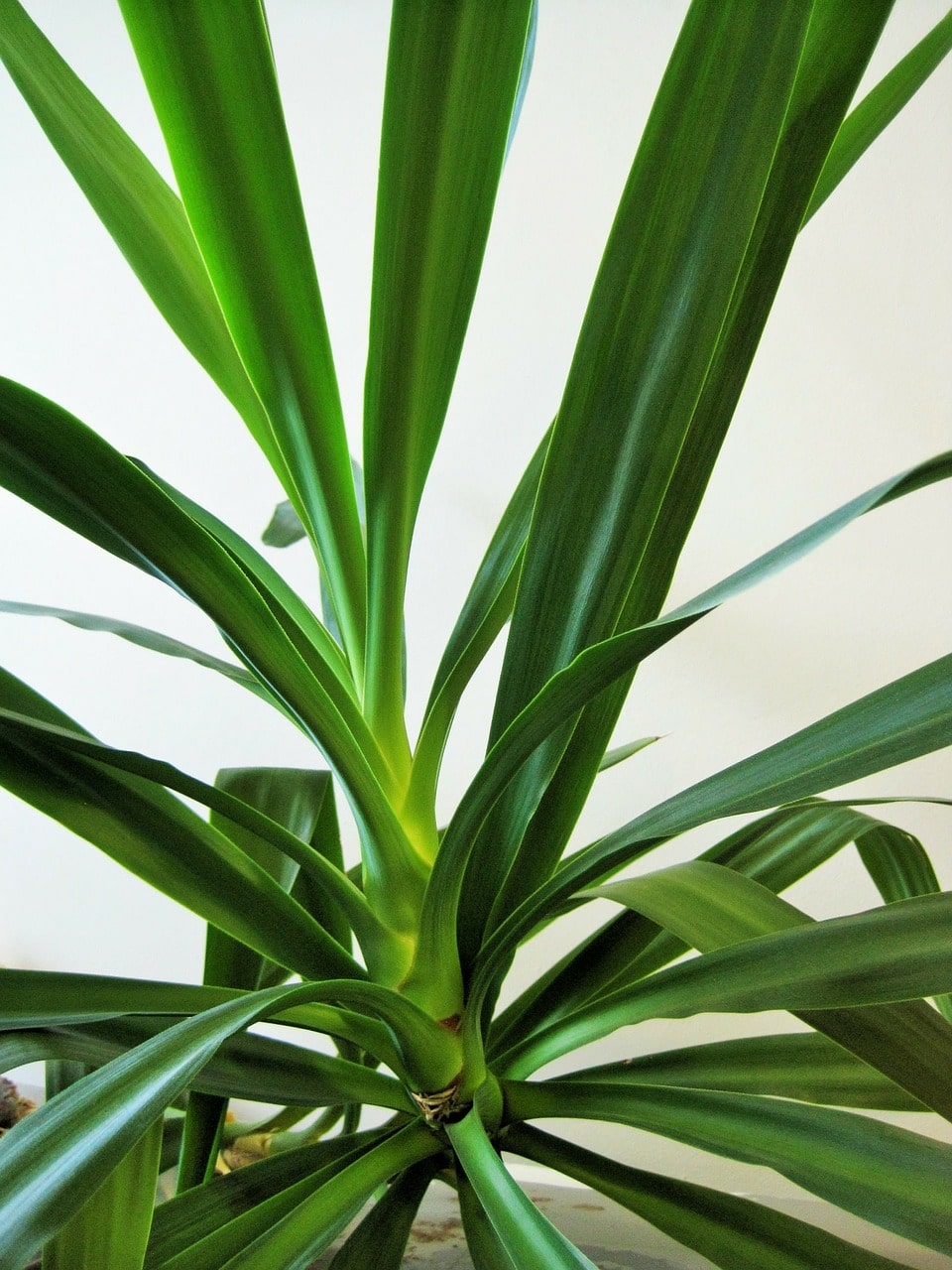
There are several fantastic-looking cultivars under the Yucca name.
With thick tree-like trunks, they make a perfect choice for a chameleon tank, giving your lizard something sturdy to climb on.
The spiky foliage creates an exotic accent, and Yuccas are rated as one of the best plants for air-cleaning.
- Lighting: The best lighting condition for Yucca is usually partial shade. Allowing them to get some bright light each day without overwhelming them with hours of direct sunlight is best. Yuccas will often tolerate too much light, but may get stressed out and begin to turn yellow as a result.
- Water and Soil: Yuccas need to be planted in a pot with excellent drainage. As far as water goes: aim for moist, but not wet. (Yuccas really dislike being overwatered). Give them a chance to dry out a bit between waterings, and use a pot with holes to provide proper drainage. Use light soil that isn’t compacted.
- General Care Tips: Indoor Yucca plants usually come in one of two ways: as a “tree” with a single stalk supporting one bunch of foliage or, as a “shrub” with several stalks and multiple points of foliage. You can prune them to maintain a shorter stature, just take care not to get cut or poked by the spiky leaves. On that note, it’s best to wait until your lizard is slightly mature before adding a Yucca to the mix. Baby chameleons are more likely to be injured by the spikes.
5. Dracaena Compacta
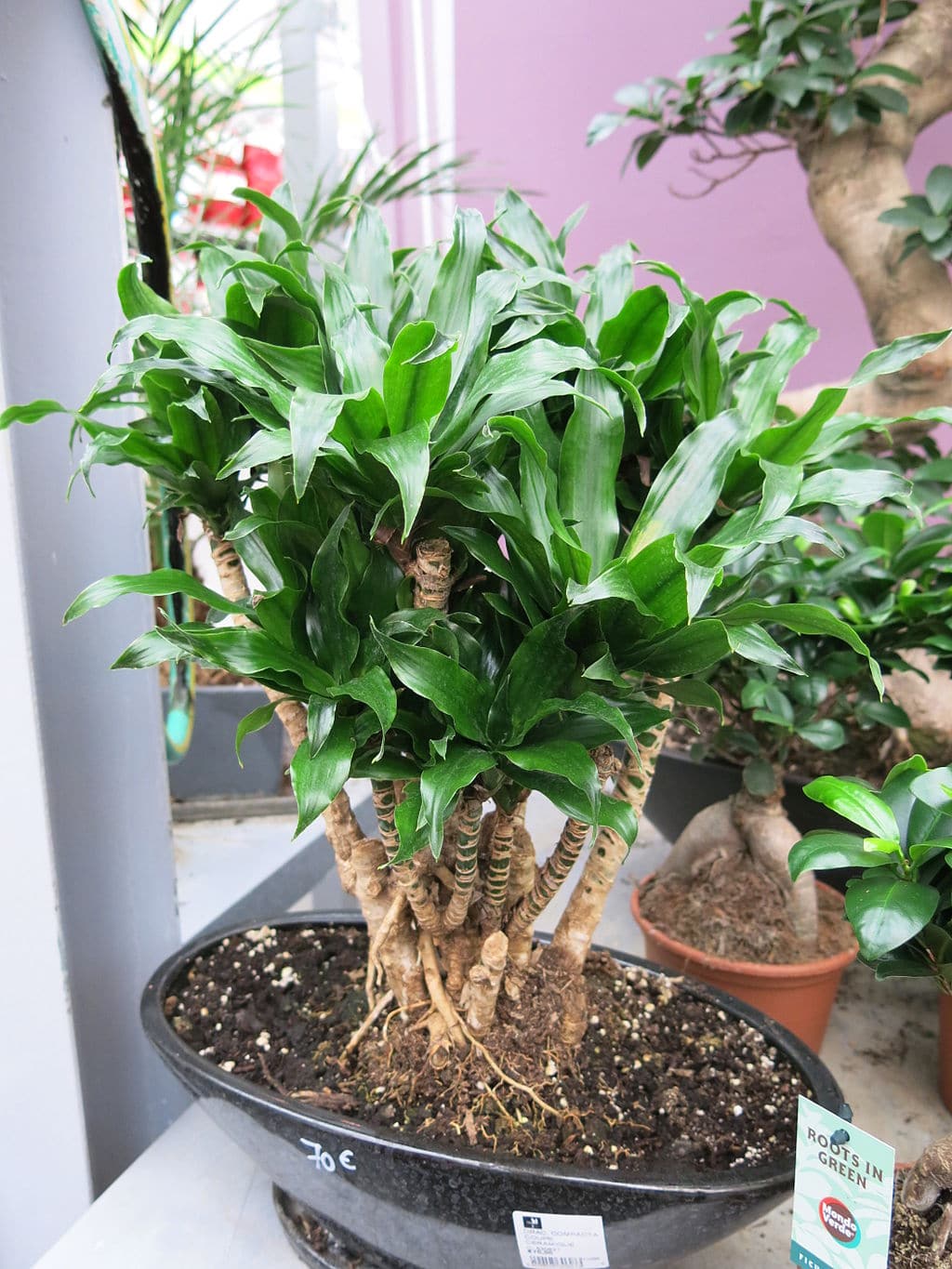
Dracaena Compacta – or the Compact Dragon Tree – is a popular pick for chameleon habitats.
With its deep green leaves and tightly packed arrangement, compacta makes an especially attractive feature for your tank.
It doesn’t get very tall and it grows slowly, making this variety all the more ideal for use inside a vivarium.
This plant is also quite robust, with thick trunk-like canes providing support for climbing lizards.
- Lighting: Dracaena plants are sometimes touted as being shade tolerant. However, in practical application, you may find that “shade tolerant” is not the same as “shade loving.” Compactas can do well in areas where there is not an abundance of bright light, but they will begin to show signs of stress without enough UV light.
- Water and Soil: Dracaena varieties need good drainage. They’re pretty tough, but don’t tolerate overwatering very well. In fact, you can let the soil dry out completely between each watering. Plant them in soil that’s airy and drains easily.
- General Care Tips: These plants are slow to display symptoms of problems. If you’re not taking proper care of yours, it will probably continue looking good for a while. Then, seemingly without warning, your dracaena will start to go downhill fast. By this time, it’s hard to play catch-up and save the plant. For this reason, it’s especially important to take good care of these pretty little trees.
6. Hibiscus
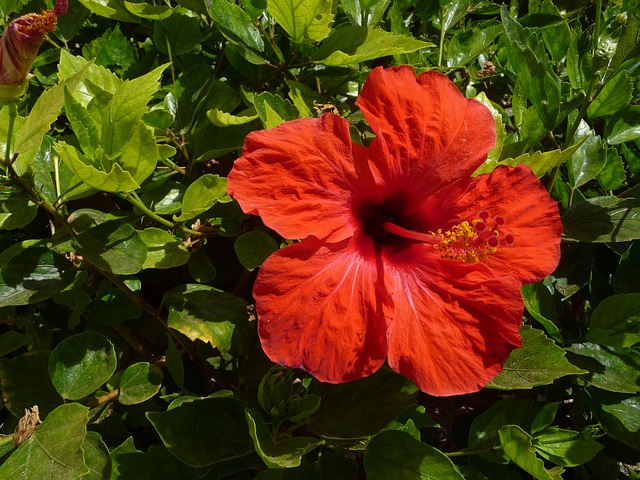
Hibiscus plants produce elegant, frilly-edged blossoms that display brilliant shades of purple, yellow, orange, and more.
Lots of Hibiscus varieties are available for plant hobbyists, but most of them are notoriously difficult to grow indoors.
One exception is the Hibiscus rosa-sinensi (commonly called the Chinese Hibiscus).
This variety offers all the delicate beauty that makes the Hibiscus so beloved, without being so high maintenance.
- Lighting: You’ll definitely need to provide adequate light for a hibiscus plant. If you find that the light inside your vivarium is not sufficient to keep your Hibiscus at its best, you may want to consider keeping more than one specimen. This way you can rotate them between the tank and a bright, sunny location within your home.
- Water and Soil: Water your Hibiscus generously, but do allow the soil to dry on the surface before watering it again. Houseplant soil works fine for Hibiscus plants, just stay on top of the repotting; they don’t like to be rootbound at all.
- General Care Tips: To keep your Hibiscus short and prolific, trim it back aggressively once a year. It might seem counterintuitive to cut back all the beautiful growth, but your plant will be healthier in the long run if you do.
7. Bromeliads
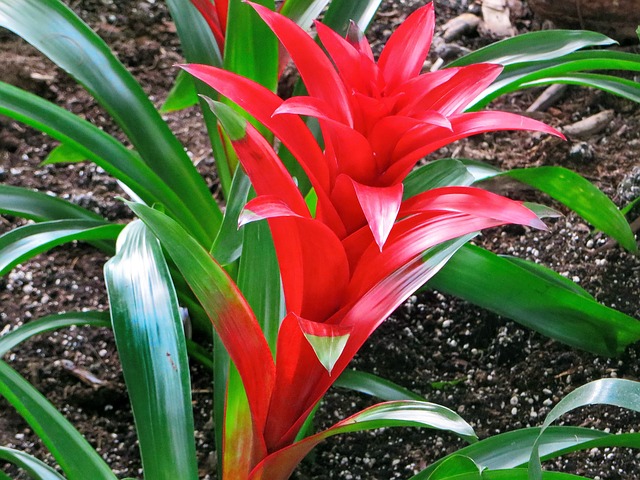
It’s not a huge surprise to find out that beautiful Bromeliads are actually related to the pineapple.
Spiky, tropical, and uniquely attractive – Bromeliads are well-loved across the spectrum of plant hobbyists.
Bromeliads only flower toward the end of their life cycle. However, the leaves develop a vivid flush of color that mimics the look of an actual flower quite effectively.
These gorgeous plants add color and texture to your tank, and they are generally sturdy enough to support an adventurous chameleon.
- Lighting: Bromeliads love heat and light. It’s true that people have successfully grown Bromeliads in low-light environments, but that’s certainly not ideal. If you want them to grow nicely – and eventually produce flowers – make sure they’re near a window or under a suitable UV light.
- Water and Soil: It’s important not to overwater your Bromeliads. Once a month is usually sufficient to keep them from drying out. Some plant hobbyists find their Bromeliads to be sensitive to minerals in tap water. Consider using distilled water for yours to avoid any issues. Use a nutrient-rich succulent soil blend to help your Bromeliad live its best life.
- General Care Tips: The stunning Bromeliad is surprisingly low key when it comes to basic care requirements. It’s pretty adaptable to a range of temperatures, although they do require a bit of humidity to thrive. You don’t have to worry much about pruning these plants, but you can snip off a cutting or two in order to start new babies. Bromeliads can go years between replantings, since their root systems develop very slowly. You may still want to mix in some fresh soil periodically to make sure the plant has access to plenty of delicious nutrients.
8. Jade Plant
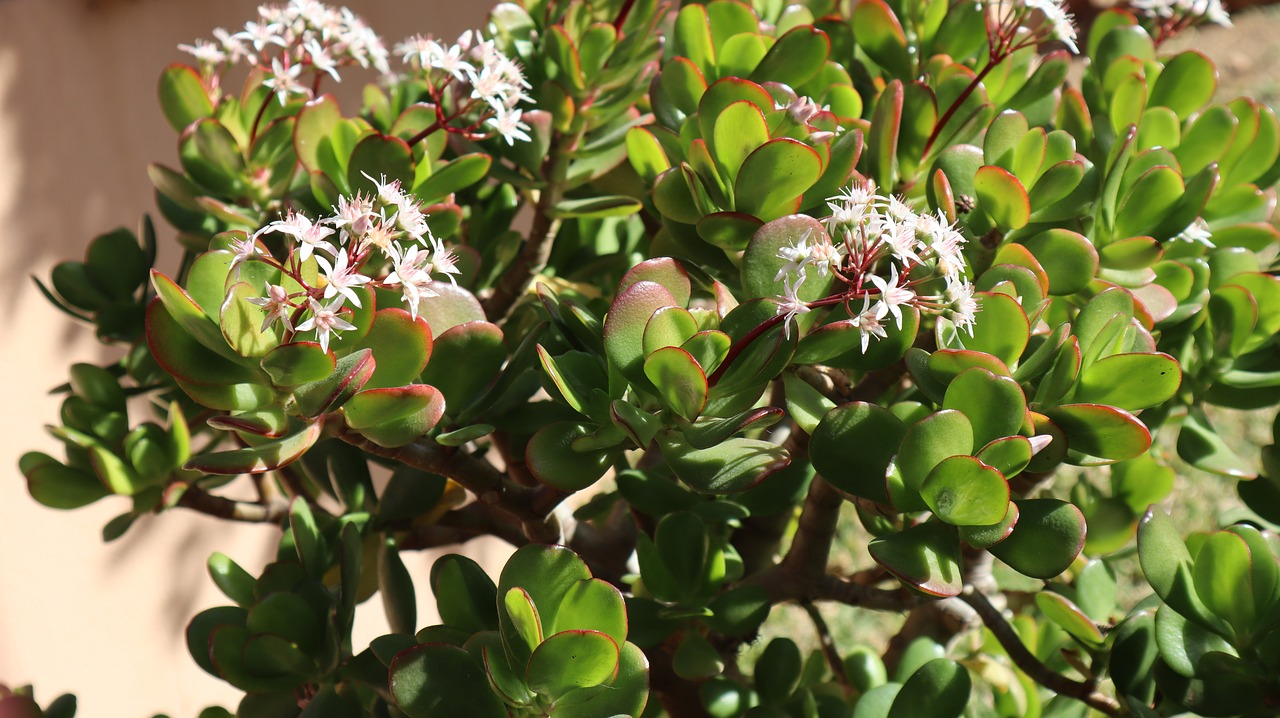
Jade plants impart a lush, exotic flair to your chameleon habitat. Plus, their woody stems are strong enough for your lizard to climb on.
A fleshy succulent, Jade plants are capable of outgrowing even very large terrariums, so keep these beauties trimmed back.
- Lighting: Jade plants need several hours of good, direct lighting every day. Place them where they will be sure to get plenty of solid coverage from your UV setup. Some people remove their Jade plant to a sunny window daily (or at least every few days) to ensure they’re getting enough light.
- Water and Soil: Since they are succulents, Jade plants don’t need tons of water. In fact, they’re happier when you don’t give them much water at all – especially in the winter months. During this time, allow your Jade plant’s soil to dry out before watering it again. The rest of the year, keep the soil moist (but not wet). Many experts will tell you to use distilled or purified water for jade plants, as the sodium in a lot of tap water can be detrimental to them.
- General Care Tips: Jade plants don’t mind having tight root systems, and they can be kept in the same pot for up to 5 years before replanting. If you repot them more often, they’ll grow faster. Keep this in mind if you’re hoping to have shorter, more compact Jades for your chameleon’s tank.
9. Nasturtiums
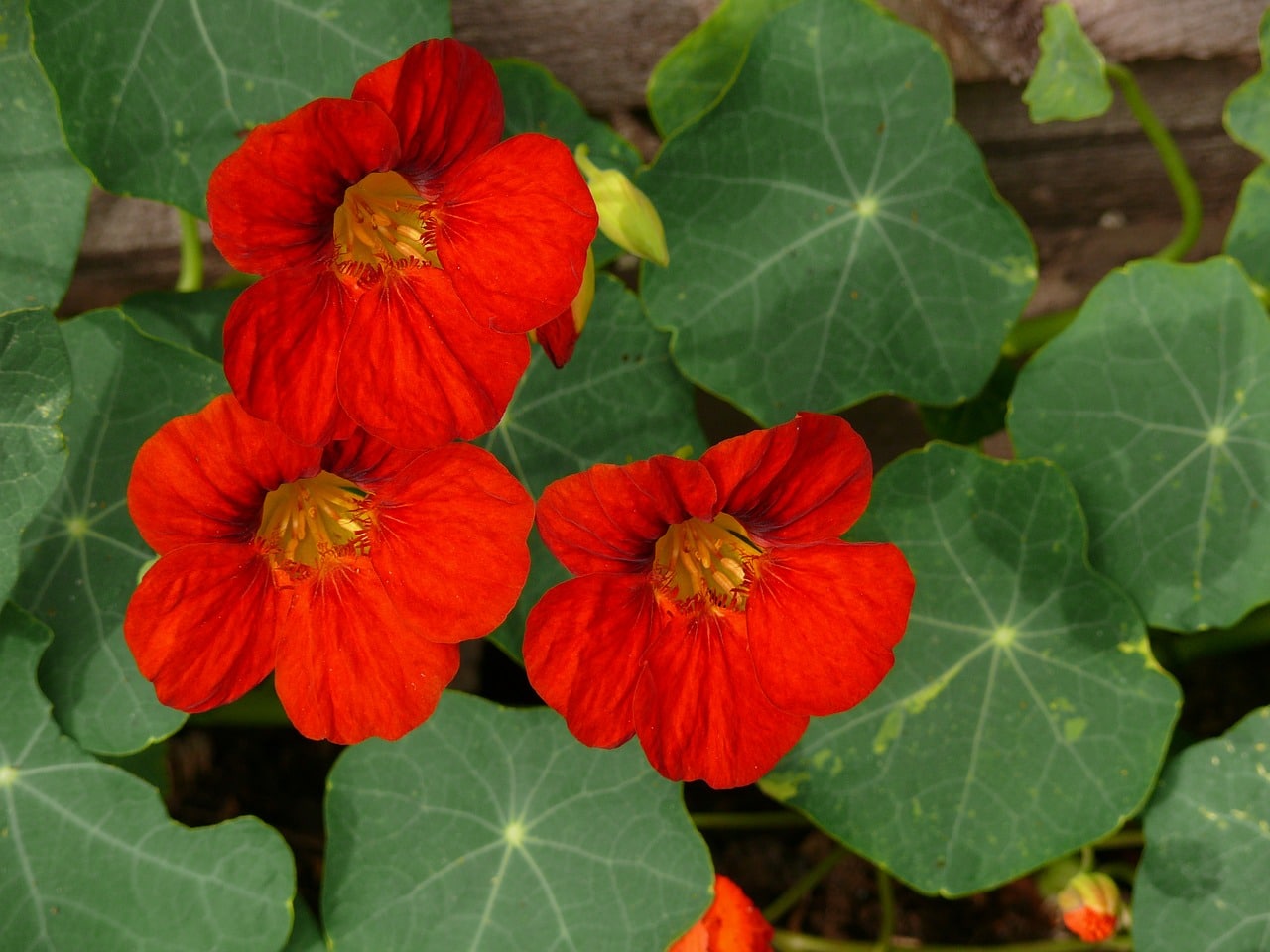
Nasturtiums create a rich display, greening up any space with their perky and vibrant leaves.
Nasturtium flowers are even more dramatic than the gorgeous foliage – appearing in bright shades of yellow, orange, red, pink, and more.
Aside from the visual appeal, nasturtiums have another major benefit: they’re edible – and tasty.
If you have a chameleon who likes to nibble on his houseplants, nasturtiums might be an especially good pick.
- Lighting: Nasturtiums need at least partial sunlight. This means you will need to make sure they’re getting plenty of UV exposure from your in-tank lighting setup.
- Water and Soil: 1-2 waterings per week is usually sufficient for Nasturtiums. As long as you keep the soil at least somewhat damp, your little Nasturtium plant should be good to go.
- General Care Tips: Nasturtiums will climb if you give them something to latch onto. Small chameleons will likely enjoy traversing the vine-like stems of a healthy Nasturtium.
10. Spider Plant
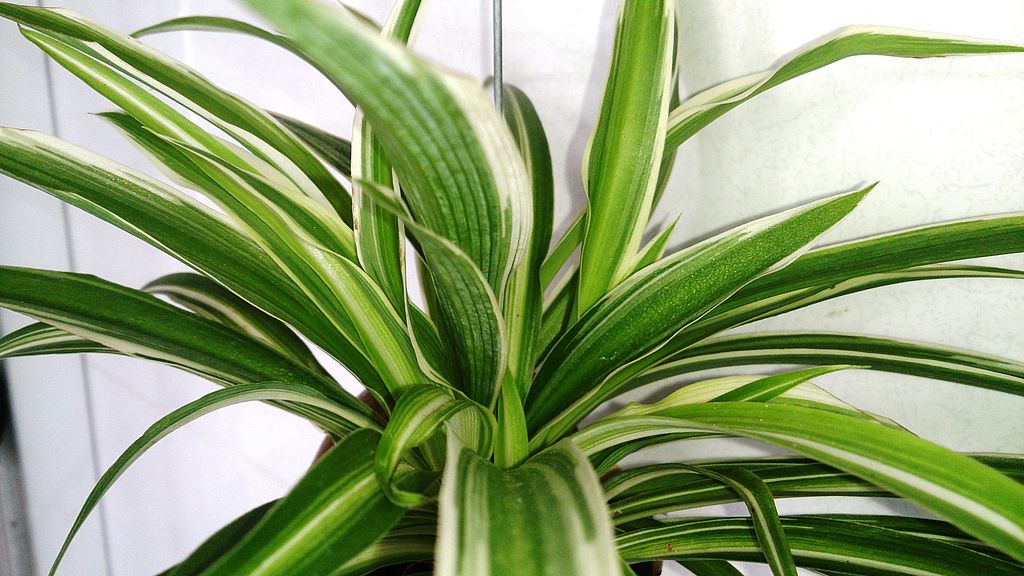
The long, spindly foliage of the Spider plant is an eye-catching space-filler for your chameleon’s tank.
Solid green, sometimes with contrasting white variegation, Spiders are pretty easy to grow – even for the novice plant-keeper.
At some point, mature spider plants will produce delicate white flowers that only add to their unique aesthetic.
- Lighting: Spider plants aren’t big on too much direct light, so make sure the light they receive is either filtered or low intensity. If they become too hot or get too much UV exposure, they’ll likely turn brown and even begin to drop leaves.
- Water and Soil: Plain old houseplant soil should suit your spider plant just fine. Keep it watered regularly. Spiders don’t really like to dry out, nor do they dig being super wet. For happy Spider plants, try to maintain a happy medium. Good drainage is also critical to keeping them healthy.
- General Care Tips: Spider plants are prolific, and will probably need to be replanted about once a year. Mature Spider plants will produce “pups,” or little baby plants, which can be snipped off and replanted to create new plants.
11. Wax Begonia
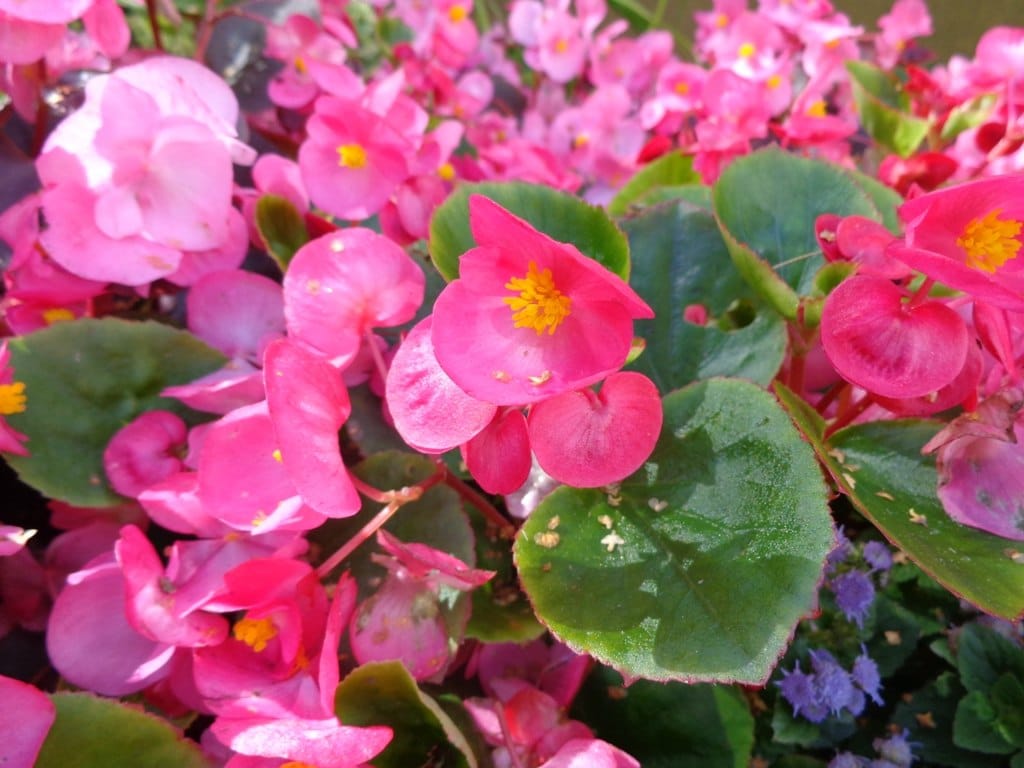
Wax Begonias always make a great filler plant for garden beds and even lizard habitats.
They are fast growing and produce lacy and colorful flowers.
They are most commonly used to populate outdoor areas, but Begonias can absolutely thrive inside when they’re well cared for.
A chameleon tank is actually a great place to cultivate Wax Begonias indoors since you can provide plenty of heat and light.
- Lighting: Wax Begonias insist on lots of bright light. They don’t mind heat, either, so feel free to arrange them somewhere near your sun lamp.
- Water and Soil: When your Wax Begonia is young, don’t let it dry out. Once established, these plants actually like having their soil a bit on the dry side – so you can dial back the frequency of watering as they mature. Use a pot with excellent drainage to avoid the dreaded root rot (Begonias are especially picky about too-wet roots). You can use a basic houseplant mix as long as it’s light and airy, since Begonias don’t like dense, compact soil.
- General Care Tips: Wax begonias are part of that strange collection of plants that actually seem to do better when they’re allowed to be a bit root-bound. This means you really don’t have to repot yours very often, cutting down on maintenance requirements. Keep it trimmed to encourage outward (rather than upward) growth.
Preparing Plants for Introduction to a Chameleon Habitat
Most plants are not sold specifically to be used in a lizard habitat. In fact, they are often treated with pesticides and other substances that could be extremely harmful to your adorable, innocent chameleon.
To remove pesticides from your plants:
- Fill your sink with warm water and antibacterial soap.
- Submerge your plants in the water, swishing them around gently to help loosen up and clean off any unwanted substances.
- Remove the plants, but allow the soapy film to sit on them for several minutes.
- Rinse them thoroughly.
- Repeat this process at least 3 times to make sure you’re not leaving traces of toxic chemicals behind.
Remember, too, that commercial soil may contain fertilizers that will harm chameleons.
That’s why it’s best to throw the original soil away and repot the plants with organic soil (unless you’re certain the original soil is safe).
Some Additional Care Tips for Chameleon Habitat Plants
While each plant has its own particular care requirements, these general guidelines can help you to be a better caretaker for your foliage-providing friends.
- Like most plants, these chameleon-friendly varieties gather the nourishment they need from the soil they’re grown in. Of course, you may need to amend the soil if a plant is missing out on some vital nutrient. If you decide to introduce any fertilizer, make sure it’s non-toxic to your lizard.
- Be mindful of heat when caring for the plants in your chameleon habitat. Some plants will die if kept too close to heat lamps, while others love to bake in the hot light. Arrange the plants in your tank accordingly.
- Wash your plants regularly. You can use some water with a bit of dish soap (buy the fragrance and dye free kind, if possible) to carefully clean the leaves of your plants regularly. This helps the plants to stay healthy, and it keeps your pet’s home more sanitary.
- Try to keep a balance between plants and open space in the tank. Think about how you’d like to live. You need some things to sit on, maybe some objects to climb or play on. But you also need to have some clutter-free space where you can stretch out and move around.
- Trim any yellow or brown leaves to force energy to the healthy portions of the plant. It’s always best to do a clean cut; leaving jagged or uneven edges on a plant stalk is an open invitation to bugs and disease.
Common Plant Care Mistakes
If your plants aren’t thriving, these common culprits could be at fault.
Overwatering
The absolute number one killer of plants by usually well-intentioned people is overwatering. Plants need water. Too often, usually out of a fear of underwatering, we give our houseplants more water than they are able to use. This leads to a cascade of problems that can end with you throwing away a dead plant.
Underwatering
On the other end of the plant watering spectrum is, of course, underwatering. Most plants favor soil that’s allowed to dry out somewhat between waterings. However, each type of plant has its own set of favored conditions. Desert plants like cactuses and succulents don’t need as much water as many other types of plants. Be sure to follow the care instructions for the particular plant you’re working with.
Using the Wrong Soil
Different plants have different soil requirements. Succulents need good drainage, while many other kinds of house plants require more dense soil to be happy. A plant placed in unsuitable soil won’t be long for this world.
Too much (or not enough) light
Carefully read the instructions when you purchase a new plant. If it’s a low-light lover, place it where it will be shielded from direct UV rays. On the other hand, you can put light-worshipping plants right next to your lighting setup (just not too close).
Watch for these symptoms of distress, disease, or pests in your plants.
- Brown-tipped leaves
- Yellowing leaves
- Dried out leaves
- Bugs
- Fungus
When in doubt, you can consult your local plant nursery for additional care tips on any specific plant species.
Always be observant; you may find that some plants just aren’t a good fit for you and/or your pet. If your chameleon refuses to climb on or otherwise interact with a particular plant, try swapping it out for something else.
Last update on 2025-04-11 / Affiliate links / Images from Amazon Product Advertising API


Great Article. Some on the internet use dwarf umbrella trees. I’ve seen that this maybe toxic to dogs and cats. Are they really ok for chameleons ?
Yes they are fine for chameleons as long as you have the right one. There are 2 different umbrella plant species. Schefflera actinophylla is the toxic one. The Dwarf Schefflera is the safe one!